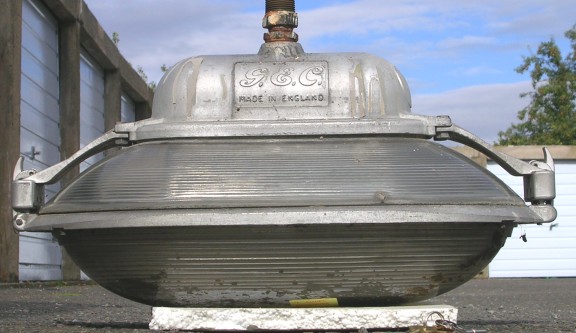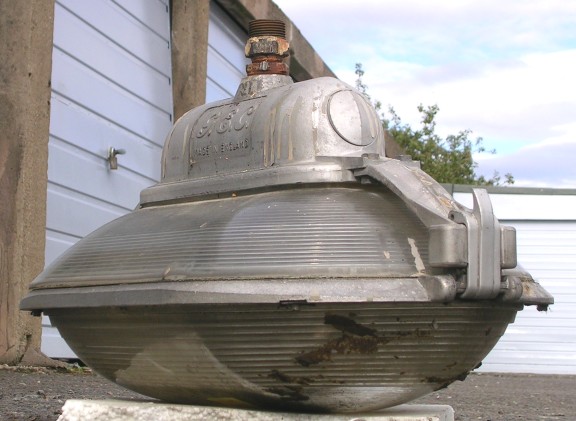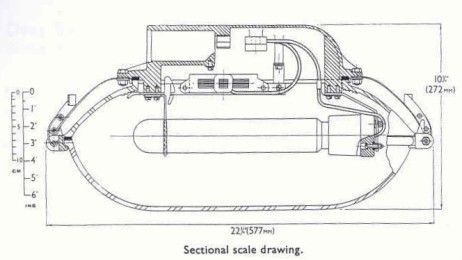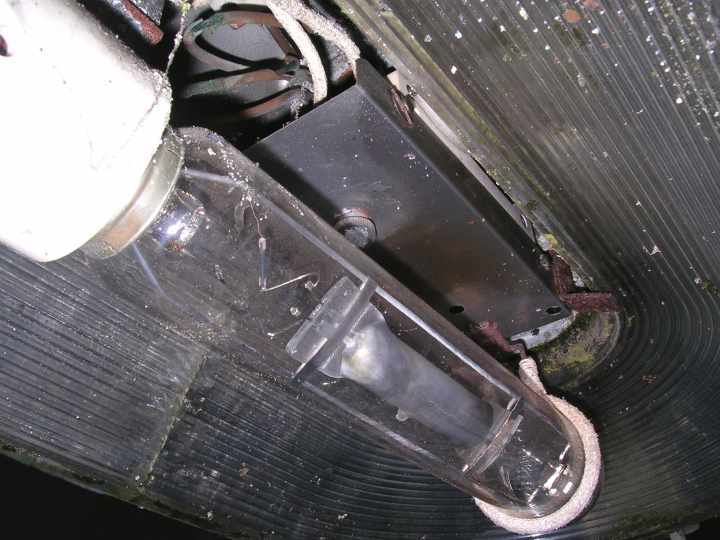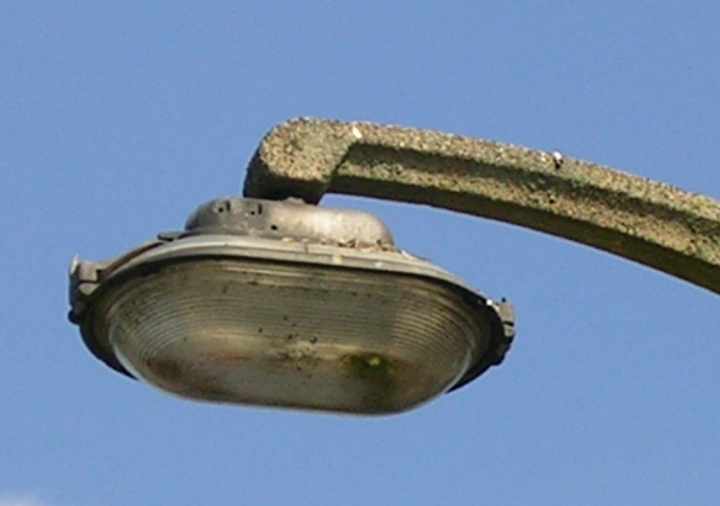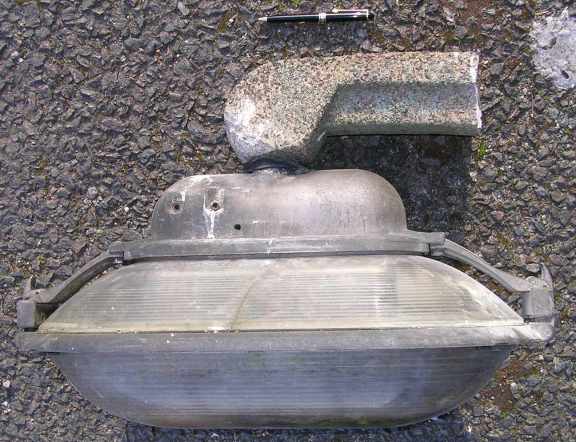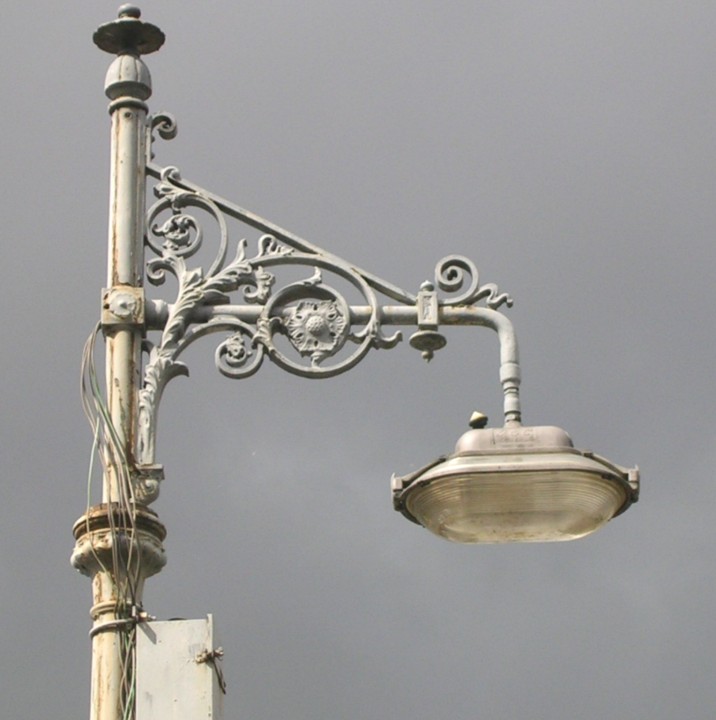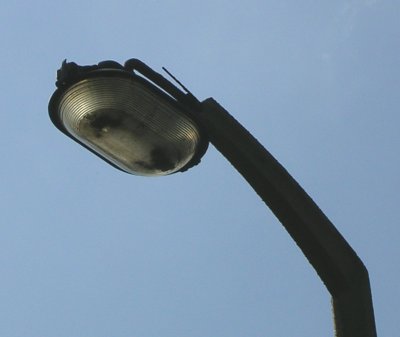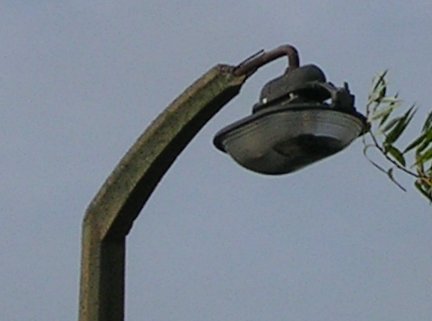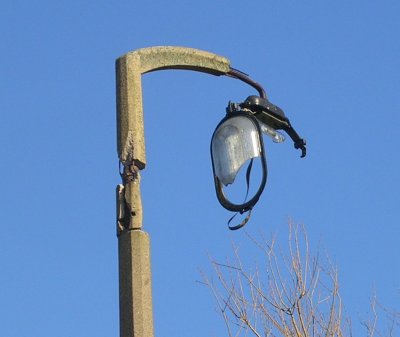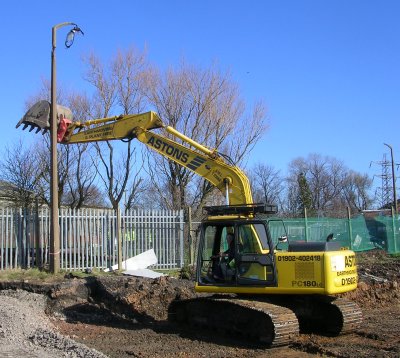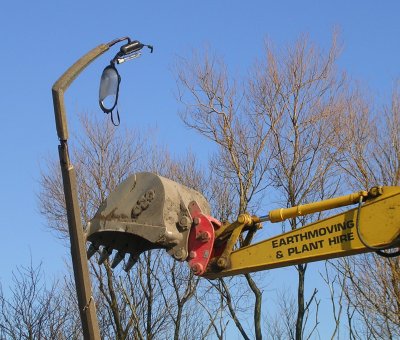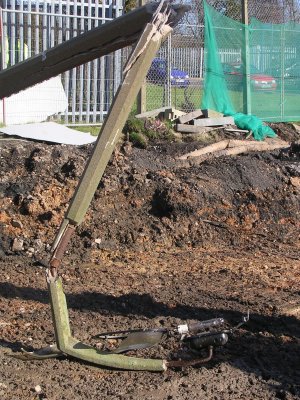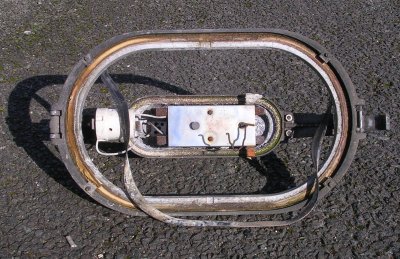GEC Z8421 'Dioptrion' 250w/400w MBF lantern for top-entry and side-entry mounting
|
GEC Dioptrion 250w/400w MBF lantern. Introduced by GEC in 1948, the Dioptrion was a popular mercury lantern whose design was quite revolutionary in that the canopy was partly constructed from prismatic glass. The all-round combination of glass bowl and canopy is unusual, and it can only be assumed that the combined optics of the prismatic canopy and bowl distributed the majority of lamplight towards the road surface below. However, a significant amount of light must have escaped above the horizontal, as there is no reflector plate in the canopy to prevent this from occurring. There are two Dioptrions held in the collection; the first example acquired came from the City of Worcester where it was situated in Pump Street until its removal in 2005, having given some 50-years continuous service. The City of Worcester still has three or four of these lanterns in use in heritage areas of the City (believed to have gone by April 2006). The second example came from an old colliery site at Rumer Hill, Staffordshire in February 2006 and had been long disused. However, it is complete and totally original. With
the advent of commercially available 'tubed' discharge lamps, manufacturers
quickly realised that significantly improved light distribution
could be obtained if the lamps were burning in a horizontal
attitude, rather that the vertical; the Dioptrion is
an early example of a commercial lantern designed for use with
horizontally mounted mercury lamps. However, these medium
pressure lamps (MA lamps) couldn't effectively burn in a horizontal orientation as
the convection currents in the
discharge tube within the lamp caused the arc to bow upwards, eventually
destroying the lamp's aluminosilicate hard glass arc tube. To overcome this problem,
lanterns such as the Dioptrion were fitted with electro
magnetic arc-defectors to counteract The Dioptrion was once popular with many local authorities throughout the UK, and it was still common to find examples surviving into the 1970's. Today, very few exist and those that do are often damaged or vandalised; not surprisingly, it has taken me many years to locate and acquire the two examples now held in the collection. Both Dioptrions are currently stored and await restoration. If
you want more detailed technical information on discharge
lamps, then do visit James Hooker's excellent website
at www.lamptech.co.uk.
This lovely example came from the City of Worcester where it had remained in use until 2005. Because it had been in constant use until its removal in 2005, it remains in excellent condition. It is seen in acquired condition in August 2005.
The GEC Dioptrion was suitable for both top-entry and side-entry mounting. The side-entry mounting hole on this lantern is blanked off.
Access to the Dioptrion's interior is made by releasing the two end toggle fasteners, which allows the bowl of the lantern to hinge downwards on a forward mounted hinge. The Dioptrion is a superbly engineered lantern, and all toggle fasteners and hinges worked perfectly on both examples, despite many decades of being exposed to the elements.
A sectional drawing of the Dioptrion from GEC's 1948 catalogue. These lanterns are 10 ¾ " in overall height and 22 ¾ " in overall length. A sectional view of the electro magnetic arc-deflector can be seen above the lamp.
The 'Cannock' Dioptrion showing the Arc Deflector mounted above the lamp. Care needs to be taken with the crumbly asbestos present in these old lanterns.
The disused Dioptrion when still in situ at Rumer Hill, Cannock in September 2005. Although originally intended for MA/H lamps, this had a 400w MB/U lamp fitted.
The same Dioptrion as seen above with part of the concrete bracket still attached! Sadly the glass canopy has been cracked at some point in the distant past. The Biro pen gives some idea as to the size of the Dioptrion lantern.
A GEC Dioptrion on a highly decorative cast iron bracket and column in Worcester. The Dioptrion is most likely a second generation lantern for this lovely old column. Note the two-part photocell sticking out of the top of the lantern.
Dioptrion update; 9th March 2007 The following series of pictures shows what was to become the last remaining GEC Dioptrion at the former Mid Cannock Colliery which had closed closed in 1967 (later becoming part of the now defunct rail-served Mid Cannock Coal Disposal Point). The original colliery site had been divided up, and parts of it had been sold off by British Coal; the lantern in question was situated on the boundry of what had once been the main complex. The land on which this Dioptrion stood was sold off for redevelopment in 2005, and it was evident that the Dioptrion would be swept away when the site was eventually cleared. Trying to save this lantern became a very long and drawn out process and in the end my attempts to save it while it still remained intact, sadly ended in failure.
This picture taken in September 2005, shows the said GEC Dioptrion at the former Mid-Cannock Colliery site. When this picture was taken this lantern was still completely intact, even though this underside view doesn't show the glass canopy. Several attempts to get the lantern saved at this point in time ended in frustration.
Photographed from some distance away on the 12th October 2006, the Dioptrion had by now lost its glass canopy. With the canopy missing, the lantern's magnetic arc-deflector is revealed. At about this time in late 2006, Carey's Ltd, who were the main contractors on the site, were approached by myself and after several visits, permission was finally granted by Careys to allow the rescue the damaged lantern. However, its removal wouldn't be possible until the contractors were ready to start ground works in on that section of the site in early 2007.
Several months later, and a few seconds before this photograph was taken on 2nd March 2007, the lantern's prismatic bowl was still intact, but in an attempt to bring the column down with the bucket of a hugh earth moving excavator (the only kind of vehicle that was able to get over the muddy ground to the column), the bowl unexpectantly swung open, colliding with the concrete out-reach, smashing the irreplaceable glass bowl.
In an effort to try and avoid further damaging the lantern, the contractors Komatsu excavator re-positions its mechanical arm to get a better purchase on the column and gently bring it down to the ground in a controlled manner, But the machine is totally unsuited for this kind of delicate work and is unable to execute the delicate monovering needed.
The column fractures under the force and begins to collapse under its own weight.
Despite the efforts of the driver of the excavator to bring the Dioptrion down in one piece, the old CU column eventually crumples and the lantern is finally brought to the ground. This picture shows the sad remains of the smashed Dioptrion; incredibly the 400w MB/U lamp survived the trauma. Shortly after this picture was taken, the Dioptrion was cut from the bracket and its remains were carried to safety. The broken glass bowl was beyond repair and was therefore discarded whilst still on site.
The remains of the Dioptrion after joining the Collection later the same day, seen here complete with its 400w MB/U lamp and some GEC electrical control-gear that was salvaged from the base of another disused column on the site (my sincere thanks to Steve from Rumer Hill Industrial Estate for his efforts in saving the choke for me). The choke (large box) is a GEC Z1872H (H = higher voltage 230 - 250 volts) for 400w lamps. Situated to the right of the choke (smaller box) is the GEC Z1754 (H) oil filled capacitor. Below the control gear is the bakelite cartridge fuse holder and porcelain terminal block connector.
The glass-less, bare frame of the 'Dioptrion' lantern is seen up turned in this view, but it clearly shows the valuable magnectic arc deflector to be still in situ. This Dioptrion is also interesting as it appears to be a later version with an asbestos-free interior and spring loaded lamp support holder that is now minus its spring. This was not a feature of earlier Dioptrions. The current plan is to remove the arc deflector and fit it to the ex Worcester City Dioptrion, as this is missing this original component. The remains of the lantern will be held in store as a source of spare parts. My sincere thanks to Tom Carey, Richard Emery, Nuala McGeynn, and Paul McHale of Careys Ltd for their kind assistance in saving the remains of this 1950's street lighting relic. |
Copyright(c) 2005 Claire Pendrous. All rights reserved.
Please note that all pictures are by Claire Pendrous, or are part of the Claire Pendrous photographic collection unless otherwise stated; none of these images can be copied without obtaining prior permission.
